George Dewey
George Dewey (December 26, 1837 – January 16, 1917) was Admiral of the Navy, the only person in United States history to have attained the rank. He is best known for his victory at the Battle of Manila Bay during the Spanish–American War, with the loss of only a single crewman on the American side.
Admiral of the Navy George Dewey | |
|---|---|
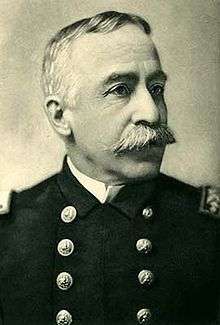 | |
| Born | December 26, 1837 Montpelier, Vermont |
| Died | January 16, 1917 (aged 79) Washington, D.C. |
| Buried | |
| Allegiance | Union |
| Service/ | |
| Years of service | 1858–1917 |
| Rank | |
| Commands held | Asiatic Squadron General Board of the United States Navy |
| Battles/wars | American Civil War
|
| Signature |  |
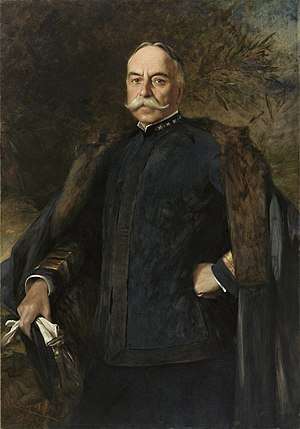
Dewey was born in Montpelier, Vermont. At age 15, Dewey's father enrolled him at Norwich University, Northfield, Vermont. Two years later Norwich expelled him for drunkenness and herding sheep into the barracks. Summarily, he entered the United States Naval Academy in 1854. He graduated from the academy in 1858 and was assigned as the executive lieutenant of the USS Mississippi at the beginning of the Civil War. He participated in the capture of New Orleans and the Siege of Port Hudson, helping the Union take control of the Mississippi River. By the end of the war, Dewey reached the rank of lieutenant commander.
After the Civil War, Dewey undertook a variety of assignments, serving on multiple ships and as an instructor at the Naval Academy. He also served on the United States Lighthouse Board and the Board of Inspection and Survey. He was promoted to Commodore in 1896 and assigned to the Asiatic Squadron the following year. After that appointment, he began preparations for a potential war with Spain, which broke out in April 1898. Immediately after the beginning of the war, Dewey led an attack on Manila Bay, sinking the entire Spanish Pacific fleet while suffering only minor casualties. After the battle, his fleet assisted in the capture of Manila. Dewey's victory at Manila Bay was widely lauded in the United States, and he was promoted to Admiral of the Navy in 1903.
Dewey explored a run for the 1900 Democratic presidential nomination, but he withdrew from the race and endorsed President William McKinley. He served on the General Board of the United States Navy, an important policy-making body, from 1900 until his death in 1917.
Early life
Dewey was born in Montpelier, Vermont, on December 26, 1837, directly opposite the Vermont State House, to Julius Yemans Dewey and his first wife, Mary Perrin.[1][2] Julius was a physician who received his degree from The University of Vermont. He was among the founders of the National Life Insurance Company in 1848,[1] a member of the Episcopal Church, and was among the founders of the Christ Episcopal Church in Montpelier. George was baptized and attended Sunday school there. George had two older brothers and a younger sister.[3]
Dewey attended school in the nearby town of Johnson. When he was fifteen years old he went to the Norwich Military School.[4] The school, better known as Norwich University, had been founded by Alden Partridge and aimed at giving cadets a well-rounded military education. Dewey attended for two years (1852–1854).[1] Dewey found a military role model when he read a biography of Hannibal.[4]
Naval career
Naval Academy
Dewey entered the Naval Academy in 1854 at the age of 16. The conventional four-year course had just been introduced in 1851 and the cadet corps was quite small, averaging about one hundred Acting Midshipmen.[1] Out of all that entered in his year, only fourteen stayed through the course. He stood fifth on the class roll at graduation.[4] He graduated from the Academy on 18 June 1858.[1]
Midshipman
As a midshipman, Dewey first went to sea on a practice cruise aboard USS Saratoga; on this cruise he earned recognition as a cadet officer. As a result, he was assigned to one of the best ships of the old Navy—the steam frigate USS Wabash.[4] Wabash under Captain Samuel Barron was the new flagship of the Mediterranean Squadron. On 22 July 1858, the ship left Hampton Roads for Europe.[1]
Wabash reached her first port of call, Gibraltar, on 17 August 1858. She cruised in the Mediterranean, and the cadet officers visited the cities of the Old World accessible to them, often taking trips inland. Dewey was assigned to keep the ship's log.[4] Wabash returned to the New York Navy Yard on 16 December 1859, and decommissioned there on 20 December 1859. Dewey served on two short-term cruises in 1860.
Civil War service
At the beginning of the American Civil War, Dewey was executive lieutenant on USS Mississippi, a steam paddle frigate assigned to the Union West Gulf Blockading Squadron.
Attack on New Orleans
At the beginning of 1862, Mississippi was attached to David Farragut's fleet for the capture of New Orleans. On the night of 24–25 April 1862, Farragut led his ships up the Mississippi River past the Confederate defenses at Fort St. Philip and Fort Jackson. Mississippi was the third in Farragut's first division, with Dewey at the helm.
The first division (all big ships) kept near the west bank where the current was weaker and the water deeper; but this brought them right under the muzzles of the guns of Fort St. Philip. Dewey steered Mississippi through shallow water where he expected to run aground any moment.[4]
There was a squadron of Confederate gunboats waiting above the forts. This included CSS Manassas, a small ironclad. Manassas tried to ram Mississippi, but Dewey safely maneuvered Mississippi to evade. Manassas then attacked Brooklyn and Hartford in the next division, and then turned back upriver.
Farragut signaled Mississippi to run Manassas down. Dewey steered Mississippi into a ramming attack. Manassas dodged, but ran aground and was abandoned. She was set on fire by a boat from Mississippi, and then shelled.[4] Farragut's fleet then continued upriver and forced the surrender of the city.
This was the first battle in which Dewey distinguished himself. For the remainder of 1862, Farragut's ships (including Mississippi) patrolled the lower river. This was dangerous, as the ships were fired on by Confederate sharpshooters on the banks, and even occasionally by light artillery.[4]
Battle of Port Hudson
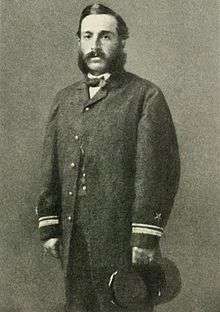
In spring 1863, Union forces moved to take the Confederate fortress at Port Hudson, Louisiana, where at that time the Red River joined the Mississippi. Farragut attempted to pass the fortress with his fleet and cut it off upriver, thereby completing the Siege of Port Hudson.
The attempt was made on 14 March 1863. In this action, Dewey saw fiercer fighting than he was ever to see again. Mississippi ran aground and was the target of concentrated enemy fire for half an hour, until she had to be abandoned. Dewey was among the last to leave the wreck.[4]
Assignment to USS Agawam
Dewey was highly complimented by his immediate superiors and by Farragut himself, who appointed him executive officer of USS Agawam, a small gunboat the admiral used frequently for dispatches and his personal reconnoitering. This little vessel was frequently under fire by concealed sharpshooters and temporary batteries. In July of that year a small engagement at Donaldsonville, Louisiana, resulted in the death of Captain Abner Read, of USS New London, and the severe wounding of his executive officer. Dewey was present, and was so conspicuous for gallantry that he was recommended for promotion on the strength of it. Meanwhile, he was given temporary command of the frigate.[4]
Assignment to USS Colorado
In the latter part of 1864, after some service in the James River under Commander McComb, Lieutenant Dewey was made executive officer of the first-rate wooden man-of-war USS Colorado, in the North Atlantic Blockading Squadron under command of Commodore Henry Knox Thatcher.
Battles of Fort Fisher
By late 1864, Wilmington, North Carolina, was the only port left to the Confederacy. Its access to the sea was protected by Fort Fisher, at the mouth of the Cape Fear River.
A joint Army-Navy attack in December failed (the First Battle of Fort Fisher, 7–27 December 1864).[4]
A second attack came in January (the Second Battle of Fort Fisher, 13–15 January 1865). Colorado was engaged, and Dewey played a key role in her success.
Colorado, being a wooden ship, was placed in the line outside the monitors and other armored vessels but got a full share of conflict. Toward the end of the second engagement, when matters were moving the right way, Admiral Porter signaled Thatcher to close in and silence a certain part of the works. As Colorado had already received considerable damage, her officers remonstrated. But Dewey, who had now acquired marked tactical ability, was quick to see the advantage to be gained by the move and the work was taken in fifteen minutes. The New York Times, commenting upon this part of the action, spoke of it as "the most beautiful duel of the war". When Admiral Porter came to congratulate Commodore Thatcher, the latter said generously: "You must thank Lieutenant Dewey, sir. It was his move." Nevertheless, Thatcher was promoted to rear admiral. He tried to take Dewey with him as his fleet captain when he went to supersede Farragut at Mobile Bay. This was not permitted, but Dewey was promoted to lieutenant commander.[4]
Post–Civil War life
After the end of the Civil War, then Lieutenant Commander Dewey remained in active service, and was sent to the European station as executive officer of USS Kearsarge — the famous ship that had sunk the Confederate privateer Alabama.
Peacetime assignments
Dewey's next tour of duty was in 1867 and 1868 as executive officer of USS Colorado—the same vessel in which he had won his honors at Fort Fisher, and now the flagship of the European Squadron. The admiral in command of the ship and squadron was Louis M. Goldsborough, and one of Dewey's companions was John Crittenden Watson—the same man, who, as rear admiral, relieved Admiral Dewey of his duties at Manila, when he wished to return to the United States in the summer of 1899.[4] Lieutenant Commander Dewey was in charge of the vessels at the Naval Academy in Annapolis from 6 November 1867 through 1 August 1870. This duty included commanding the famous frigate USS Constitution, which was berthed at Annapolis as a training ship.
Some tranquil years followed the end of Dewey's cruise on Colorado. For two years, from 1868 to 1870, he was an instructor at the Naval Academy. The next year he did special surveying work on the steam sloop USS Narragansett. He was then briefly assigned to the Naval Torpedo Station at Newport, Rhode Island. It was during this assignment that his wife died just after the birth of his son. In 1873 Dewey was given command of Narragansett and spent nearly four years on her, engaged in the Pacific Coast Survey.[4]
Lighthouse Board
This entitled him to a period of rest ashore; and he was ordered to Washington, and made lighthouse inspector in 1880, and then secretary of the lighthouse board, a service in which he took great interest. Meanwhile, he had been promoted to the grade of commander. This residence in Washington as a bureau officer of high rank gave him an extensive acquaintance, and he became one of the most popular men in the capital. He was a member of the Metropolitan Club, the leading social club of Washington.[4]
Assignment to USS Dolphin
In 1882, this leave of absence in Washington came to an end when he was sent to the Asiatic station in command of USS Juniata, where he studied the situation with care and acquired information of immense importance ten years later.[4]
He was promoted to the rank of captain in 1884, and he was ordered home and given command of USS Dolphin—one of the first four ships of the original "white squadron", steam-powered ships with steel hulls which formed the basis of the modern United States Navy. Dolphin was officially classed as a dispatch boat, and was often used as the Presidential yacht.[4]
In 1885, Captain Dewey undertook another tour of sea service, and for three years was in command of USS Pensacola, familiar to him in the New Orleans battles, now flagship of the European squadron.[4]
Returning to Washington in 1893, he resumed the life of a bureau officer, being attached to the lighthouse board. In 1896, he was promoted to commodore and transferred to the Board of Inspection and Survey.[4]
Spanish–American War
Commander of Asiatic Squadron
In 1896, Dewey applied for a sea posting as Commander of the Asiatic Squadron. Although Dewey was a long shot for the position, his friend Theodore Roosevelt arranged for President William McKinley to select Dewey over a more senior officer.[5]:40–41 The Commodore hoisted his pennant on board USS Olympia at Nagasaki in January 1898, and departed for Hong Kong in February to inspect the U.S. warships lying in Hong Kong harbour.[6] Upon arrival, he learned that the Maine had blown up in Havana Harbor.[7] Dewey was skeptical that the country would go to war, writing, "I don't see what we have to gain in a war with Spain."[8] However, he was confident of victory, writing, "I expect to capture the Spanish ships and reduce the defenses of Manila in one day."[9]
As the war clouds loomed, Dewey assembled his squadron at Hong Kong and made preparations. The cruiser USS Baltimore was dispatched to Hong Kong via the Republic of Hawaii. Dewey purchased the merchant colliers Nanshan and Zafiro, retaining their crews. The warships were repainted from white to gray. Upon the outbreak of war between the United States and Spain, the United Kingdom declared its neutrality and Dewey was ordered by Wilsone Black to leave British waters. The Asiatic Squadron moved to the Chinese waters of Mirs Bay.
Battle of Manila Bay
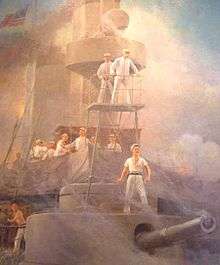
On April 27, 1898, he sailed from China aboard USS Olympia with orders to attack the Spanish at Manila Bay. He stopped at the mouth of the bay late the night of April 30, and the following morning he gave the order to attack at first light, saying the now famous words "You may fire when you are ready, Gridley." True to his word, Dewey defeated the Spanish in a battle lasting just six hours. The Asiatic Squadron sank or captured the entire Spanish Pacific Squadron under Admiral Patricio Montojo y Pasarón and silenced the shore batteries at Manila, with the loss of only one life on the American side.
Didn't Admiral Dewey do wonderfully well? I got him the position out there in Asia last year, and I had to beg hard to do it; and the reason I gave was that we might have to send him to Manila. And we sent him — and he went!
— Letter from Theodore Roosevelt to William Wingate Sewall, May 4, 1898[10]
Philippines
In the early stages of the Spanish-American War in the Philippines, Dewey and the Americans were aided by the Filipino nationalists led by Emilio Aguinaldo who had fought previously the Philippine Revolution and were attacking the Spanish by land after Dewey had defeated the Spanish at sea. There were no U.S. Army ground troops in the Philippines at the time. Dewey and Aguinaldo at first enjoyed a cordial relationship, and Dewey wrote that the Filipinos were "intelligent" and well "capable of self-government." In August after ground troops arrived, Dewey aided U.S. Army General Wesley Merritt in taking possession of Manila on August 13, 1898, during the 1898 Battle of Manila, the "mock Battle of Manila", while Aguinaldo's troops, surrounding Manila, were kept out. In February 1899, the Philippine–American War started.
Hero
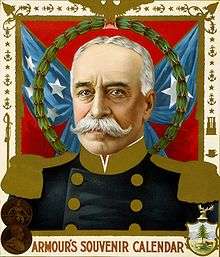
Dewey was promoted to rear admiral in May 1898, and full admiral the following year. Returning to the United States on September 27, 1899, Dewey received a hero's welcome. New York City's September 1899 welcome-home celebration for Dewey was a two-day parade. When Boston paid tribute, he was greeted at City Hall by 280 singers from the Handel and Haydn Society who sang the anthem "See the Conquering Hero Comes" from Handel's Judas Maccabaeus.[11] By act of Congress, he was promoted to the special rank of Admiral of the Navy in 1903, with his date of rank retroactive to 1899.[12]
A special military decoration, the Battle of Manila Bay Medal (commonly called the Dewey Medal), was struck in honor of Dewey's victory at Manila Bay. It was awarded to every American officer, sailor, and Marine present at the battle. The medals were designed by Daniel Chester French, sculptor of the Lincoln Memorial, and produced by Tiffany & Co. of New York. Each medal was engraved with the recipient's name, rank, and ship. Since his own image appeared on the obverse of the medal, out of modesty, Dewey wore his medal reversed. Dewey was one of only four Americans in history (the other three being Admiral William T. Sampson, Admiral Richard E. Byrd, and General John J. Pershing) who were entitled to wear a US government-issued medal with their own image on it. Such was his high regard by the public that "Dewey" was the 19th most popular boys' name in 1898, jumping from 111th the year prior.[13]
Shortly after the Battle of Manila Bay, on May 31, 1898, Dewey wrote to the Secretary of the Navy asking that 50 Chinese sailors who had served with the Asiatic Squadron at Manila Bay be allowed to enter the United States. In Dewey's letter he noted that the Chinese had "rendered the most efficient services upon that occasion" and that they had "shown courage and energy in the face of an enemy." At that time an immigration law, the 1882 "Chinese Exclusion Act", prohibited Chinese laborers from landing in the United States.[14] Dewey had enlisted the Chinese sailors against the wishes of the Navy Department and, despite his very public entreatment that they be granted US citizenship, Congress refused to even take up the issue.[15]
On October 3, 1899, Dewey was presented a special sword by President McKinley in a ceremony at the Capitol building. The presentation of the sword was followed by a parade down Pennsylvania Avenue. Congress, by unanimous vote, had authorized $10,000 to fund the gift shortly after the Battle of Manila Bay. The elaborately decorated sword was custom-made by Tiffany & Co. Its hilt and fittings were made of 22 carat gold. The sword is now on display, along with uniforms and medals belonging to Admiral Dewey, at the National Museum of the United States Navy at the Washington Navy Yard.[16]
Politics
Many suggested Dewey run for President on the Democratic ticket in 1900. His candidacy was plagued by public relations missteps. He was quoted as saying the job of president would be easy since the chief executive was merely following orders in executing the laws enacted by Congress and that he would "execute the laws of Congress as faithfully as I have always executed the orders of my superiors." He admitted to never having voted in a presidential election. He drew yet more criticism when he offhandedly, but prophetically, told a newspaper reporter that: "Our next war will be with Germany."[17] Dewey also angered some Protestants by marrying a Catholic and giving her the house that the nation had given him following the war.[18] Dewey withdrew from the race in mid-May 1900 and endorsed William McKinley.
In 1900, after his withdrawal from the presidential race, he was named president of the newly established General Board of the Navy Department, which was the Navy's major policy‑making body. He remained in active naval service on the board until his death, and played a major role in championing the introduction of new technologies into the expanding U.S. Navy with his support of the development of naval aviation and the submarine.
Marriages and death
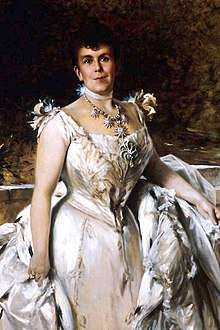
In 1866, Dewey was assigned to duty in the Portsmouth Navy Yard in Kittery, Maine, and there met the woman who became his first wife:[4] Susan "Susie" Boardman Goodwin (1844–1872), daughter of New Hampshire's war governor, Ichabod Goodwin,[19] a Republican who fitted out troops for the war at his own expense. The Deweys were married on October 24, 1867, and had one son, George. Susie died on December 28, 1872, five days after giving birth.[20]
The longtime widower cut a dashing figure and enjoyed the company of women. In 1893, he was escorting two women aboard a warship when he unexpectedly ran into his son. Thinking on his feet, Dewey introduced his son as his younger brother.[5]:40–41
On November 9, 1899, after his triumphal return from the Far East, Dewey was married for the second time to Mildred McLean Hazen (1850–1931),[21] widow of General William Babcock Hazen, in the rectory of St. Paul's Catholic Church in Washington, D.C. Since Hazen was a Roman Catholic and Dewey was not, they were not permitted to have their wedding inside a Catholic church.[22][23] The marriage was criticized by some anti-Catholic voices, as was Dewey's transfer to his wife of the $50,000 Washington mansion given to him by the American public through a fund-raising campaign.[24][25][26][27]
In later life Dewey wore stylish clothes and a handlebar mustache, which was his trademark. His inherited wealth allowed him to live in comfort. He often went horseback riding with President Theodore Roosevelt in Washington's Rock Creek Park, and he was a fellow member of Washington's prestigious Metropolitan Club.
Admiral Dewey died in Washington on January 16, 1917. After lying in state at the United States Capitol rotunda,[28] his remains were interred at Arlington National Cemetery. A mausoleum was later built for him in the cemetery. In 1925, his widow had his remains transferred to the Bethlehem Chapel, on the crypt level, at the Washington National Cathedral, Washington, D.C.[29]
Memberships
_-_Frank_A._Nankivell_'89_LCCN2012647342_(cropped).jpg)
Admiral Dewey belonged to numerous military, patriotic and hereditary societies.
In 1901, Admiral Dewey was elected as an honorary member of the New York Society of the Cincinnati.
In 1882, Dewey was elected as a First Class Companion of the District of Columbia Commandery of the Military Order of the Loyal Legion of the United States (MOLLUS) and was assigned insignia number 2397.
Dewey was a key leader in the Naval Order of the United States (insignia number 207). He served as Commander of the New York Commandery of the Naval Order of the United States from 1898 to 1900, and as Commander General (i.e., National President) of the Order from 1907 to 1917.
He was also a member of the Pennsylvania Society of the Order of the Founders and Patriots of America (state member number 93 and national member number 552) and served as Governor General from 1904 to 1906 and from 1906 to 1908, the Vermont Society of the Sons of the Revolution (state membership number 220 and national member number 2920), the Vermont Society of the Sons of the American Revolution (state member number 220 and national member number 2920), the Vermont Society of Colonial Wars (insignia number 2663), the New Jersey Society of the General Society of the War of 1812 (state membership number 15), the Society of American Wars, and the Pennsylvania Commandery of the Military Order of Foreign Wars (insignia number 363).
Dewey's membership insignia for most of the societies listed above are in the collection of the National Museum of the United States Navy at the Washington Navy Yard.
Dewey was an early member of the board of directors of the Boy Scouts of America, serving until his resignation from that office in late 1910.
Dates of rank
- Acting Midshipman, United States Naval Academy: September 23, 1854
- Warranted Midshipman: June 11, 1858
In the mid to late-18th Century, the US Navy had three "ranks" of Midshipmen serving: "acting midshipmen" who were active students at the US Naval Academy, "warranted midshipmen" who had completed most of their studies at the Academy and were serving at sea while holding line authority through a warrant of authority, and "passed midshipmen" who had completed all requirements for commissioning and held warranted line authority similar to ensigns of the modern US Navy. In the era of the Civil War, it was a common practice for officers to serve as a "Master" with a warrant of authority until they were commissioned. It was also common for officers to be granted shipboard commissions based on the need to fill certain jobs or billets. Dewey was therefore made a lieutenant once he "signed on" with David Farragut. He never held the ranks of ensign or lieutenant (junior grade) as those ranks were not created until 1862 and 1883, respectively.[30][31][12] Nor was he appointed to the rank of vice admiral, there being no actively serving vice admirals in the US Navy at that time.
| Passed Midshipman | Master | Lieutenant | Lieutenant Commander | Commander |
|---|---|---|---|---|
| O-1 | O-2 | O-3 | O-4 | O-5 |
| January 19, 1861 | February 28, 1861 | April 19, 1861 | March 3, 1865 | April 13, 1872 |
| Captain | Commodore | Rear Admiral | Admiral | Admiral of the Navy |
|---|---|---|---|---|
| O-6 | O-7 | O-8 | O-10 | Special Rank |
| September 27, 1884 (Retroactive to July 28, 1884) |
February 28, 1896 | May 11, 1898 | March 2, 1899 | March 24, 1903 (Retroactive to March 2, 1899) |
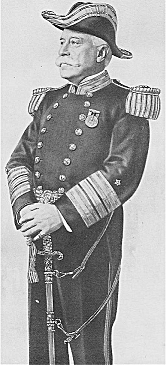
Admiral Dewey's final rank was Admiral of the Navy, making him the highest-ranking officer in the history of the United States Navy. He is the only person ever to hold this rank. Admiral of the Navy is equivalent to General of the Armies. General John J. Pershing, US Army, was promoted to General of the Armies in 1919, and Lieutenant General George Washington, US Army, was posthumously promoted on the Retired List of the US Army to the rank of General of the Armies of the United States, with an effective date of rank of 4 July 1976. [12]
Admiral Dewey served a total of 62 years on active duty in the U.S. Navy.
Honors
Medals awarded by the U.S. government
(Dates indicate the year the medal was awarded.)
- Civil War Campaign Medal (1908)
- Battle of Manila Bay Medal (aka. "Dewey Medal") (1899)
- Spanish Campaign Medal (1908)
- Philippine Campaign Medal (1908)
Note – Although Dewey was entitled to all of the above medals, he is pictured at right wearing only the Battle of Manila Bay Medal, but he is wearing the special additional gold braid on his sleeves denoting his unique rank as Admiral of the Navy.
Namesakes
- Dewey Point, Yosemite National Park, California, appeared on the first edition of the Yosemite Valley map in 1907
- Dewey Hall, an academic building at Norwich University, was constructed in 1899, in honor of his victory at Manila Bay.
- In 1898, the Borough of Hellertown, Pennsylvania, formed its fire department naming it Dewey Fire Company No. 1 in honor of George Dewey.
- Also in 1898, the city of Boston, Massachusetts, named the square besides the nearly complete South Central Station as Dewey Square in his honor.[32]
- Four vessels of the United States Navy have borne the name Dewey, including the Arleigh Burke-class destroyer Dewey, laid down on 4 October 2006, launched on 26 January 2008, and commissioned on 6 March 2010.
- Dewey Hall and Dewey Field at the United States Naval Academy in Annapolis, Maryland.
- Dewey Field at Naval Station Newport in Newport, Rhode Island.
- Thomasville, Georgia, contains the Dewey City "subdivision," an area settled in the late 1880s by former slaves.
- The column in the center of San Francisco's Union Square is dedicated to Dewey's victory at Manila Bay.
- Dewey Beach, Delaware, is named in honor of Admiral Dewey.
- Dewey Street, in St. Paul, Minnesota, was renamed in his honor.
- Dewey Avenue in Norman, Oklahoma, was named in his honor.
- City of Dewey, Oklahoma, was named in his honor. Founded in 1889 by Jacob A. Bartles.
- Dewey County, Oklahoma, was named in his honor.[33]
- In 1899, Mills Novelty released a slot machine named The Dewey, in honor of Admiral Dewey.
- The main town of Culebra, Puerto Rico, was named in his honor, however it is known by many locals simply as Pueblo.
- The Dewey School in the Castle Rock Business Corridor in Castle Rock, Colorado, was named after Admiral Dewey. The Admiral wrote a warm letter of thanks to the school children that was framed and on the wall of the school for many years until the school closed.
- Dewey Avenue in Wharton, New Jersey, is named in honor of Admiral Dewey.
- Dewey Blvd, now known as Roxas Blvd, a major seaside thoroughfare in Manila, Philippines, was named after him.
- George Dewey High School at the former U.S. Naval Base Subic Bay in the Philippines was named after him.
- A settlement in Newton County, Texas, was established as a sawmill site by the Sabine Tram Company in 1898. It was named Deweyville after George Dewey.
- Dewey Lake, a lake in St. Louis County, Minnesota, is named after Admiral Dewey.
- The tugboat Admiral Dewey was named for him.
- Dewey Road at the former San Diego Naval Training Center in the heart of the new Civic, Arts and Cultural District is named for him.
- Dewey-Humboldt, Arizona, is named in honor of Admiral Dewey.
- In San Diego, CA, George Dewey Elementary School, which is located near the former Naval Training Center and over the years served a student body which was largely made up of children of Navy and Marine personnel, was named after him.
- The World War II Liberty Ship SS George Dewey was named in his honor.
- George Dewey Medical and Wellness Center, Morong, Bataan Philippines.
Other
- Admiral Dewey March, a patriotic March named after him.
- Admiral Dewey's service sword (not to be confused with the special presentation sword he received in 1899) is on display in the wardroom of the guided missile destroyer USS Dewey (DDG-105).
See also
- Six-star rank
Notes
- Dates of promotion from The Records of Living Officers of the U.S. Navy and Marine Corps, Sixth Edition, 1889, by Lewis Randolph Hamersly.[34]
- The Dewey slot machine at Arcade-History.com.[35]
- Yosemite Place Names – The historic background of geographic names in Yosemite National Park by Peter Browning.
References
- Miller, Brian L. "George Dewey". www.spanamwar.com.
- Admiral Dewey at Manila and the Complete Story of the Philippines: Life and Glorious Deeds of Admiral George Dewey, Including a Thrilling Account of Our Conflicts with the Spaniards and Filipinos in the Orient. Philadelphia: J.H. Moore. 1899. p. 123. OCLC 6437000.
- "Julius Yemans DEWEY/Mary PERRIN". www.msu.edu.
- Lawrence, William J. ] [from old catalog. "A concise life of Admiral George Dewey, U. S. N". Boston, J. F. Murphy – via Internet Archive.
- Jones, Gregg R. (2013). Honor in the Dust: Theodore Roosevelt, War in the Philippines, and the Rise and Fall of America's Imperial Dream. New American Library. ISBN 9780451239181.
- Dewey, George (February 1, 1898). "Letter to Secretary of the Navy John D. Long".
- Dewey, George (February 18, 1898). "Letter to George Goodwin Dewey". Documentary Histories: Spanish-American War. Naval History and Heritage Command.
- Dewey, George (March 15, 1898). "Letter to George Goodwin Dewey".
- Dewey, George (March 3, 1898). "Letter to George Goodwin Dewey".
- Roosevelt, Theodore (May 5, 1898). "Letter to William Wingate Sewall, 5/4/1898". Documentary Histories: Spanish-American War. Naval History and Heritage Command.
- Louis Stanley Young, Life and Heroic Deeds of Admiral Dewey (Boston: James H. Earle, 1899), 546
- "Biography of George Dewey". public2.nhhcaws.local. Naval History and Heritage Command. 2018-12-06. Retrieved 2019-06-21.
- ""Dewey"". Behind the Name. Retrieved 31 January 2019.
- New York Times. February 23, 1899.
- ""A Navy of Foreigners, Mercenaries, and Amateurs: Naval Enlistment in the Spanish-American War"". International Journal of Naval History. Retrieved 10 November 2019.
- "Dewey Receives the Nation's Gift" (PDF). New York Times. 3 October 1899. Retrieved 4 August 2012.
- Convention Diary at www.nationalreview.com
- HarpWeek | Elections | 1900 Medium Cartoons at elections.harpweek.com
- Strawbery Banke: "The Goodwin Mansion" Archived 2008-12-27 at the Wayback Machine
- "George Dewey". www.nndb.com.
- "Dewey, Mildred McLean Hazen". Gilded Age Collections. Rutherford B. Hayes Presidential Library & Museums. Retrieved 8 October 2017.
- "Admiral Dewey Married" (PDF). New York Times. 10 November 1899. Retrieved 4 August 2012.
- Hazen was the widow of General William Babcock Hazen and the daughter of Washington McLean, a prominent Democrat and owner of The Cincinnati Enquirer.
- "Personal and Miscellaneous". The Cyclopedic Review of Current History. 9: 910. 1899. Retrieved 8 October 2017.
- Gates, Merrill E. (Editor) (1905). Men of Mark in America. Washington, D. C.: Men of Mark Publishing Company. pp. 296–297. Retrieved 8 October 2017.
Mildred McLean Hazen.
CS1 maint: extra text: authors list (link) - Stetson, Edith Warren (January 1900). "Admiral Dewey's Home and Its Mistress". Metropolitan Magazine. XI (1): 23–28.
- Ware, Susan (Editor) (1998). Forgotten Heroes: Inspiring American Portraits from Our Leading Historians. New York: The Free Press/Simon & Schuster. pp. 165–168. ISBN 0684868725.CS1 maint: extra text: authors list (link)
- ""Lying in State or in Honor"". US Architect of the Capitol (AOC). Retrieved 2018-09-01.
- "Dewey Maulsoeum".
- Navy Traditions and Customs: Ensign at the Naval History & Heritage Command (www.history.navy.mil)
- Navy Traditions and Customs: Lieutenant at the Naval History & Heritage Command (www.history.navy.mil)
- Dewey, Adelbert Milton (1899). The life and letters of Admiral Dewey. New York: Eaton & Mains. p. 411.
- Gannett, Henry (1905). The Origin of Certain Place Names in the United States. Govt. Print. Off. pp. 105.
- The Records of Living Officers of the U.S. Navy and Marine Corps. L. R. Hamersly & Company. 28 March 1898 – via Internet Archive.
- "The Dewey slot machine by Mills Novelty (1899)". www.arcade-history.com.
Further reading
- Brody, David. "Celebrating Empire on the Home Front: New York City's Welcome-home Party for Admiral Dewey." Prospects 2000 25: 391–424. ISSN 0361-2333
- Chadwick, French Ensor. The Relations of the United States and Spain: The Spanish–American War (1911) online edition
- Grenville, John A. S. and George Berkeley Young. Politics, Strategy, and American Diplomacy: Studies in Foreign Policy, 1873–1917 (1966) pp 297–336 on "The quest for security: Admiral Dewey and the general board, 1900–1917.
- Graves, Ralph. "When a Victory Really Gave Us a New World Order." Smithsonian 1992 22(12): 88–97. ISSN 0037-7333 Fulltext: Ebsco
- Spector, Ronald. Admiral of the New Empire: The Life and Career of George Dewey. 1974. 220 pp. the standard scholarly biography
- Mahan, Alfred Thayer (1899). Lessons of the War with Spain: And Other Articles. Little, Brown Low, Boston. pp. 320. Url
Primary sources
- Dewey, George. Autobiography of George Dewey, Admiral of the Navy (1913) full text online written in collaboration with journalist Frederick Palmer as ghostwriter using the reports of Dewey's aide, Nathan Sargent,
External links
| Wikimedia Commons has media related to George Dewey. |
- Dewey biography on Spanish American War Centennial Website – includes links to some of Dewey's letters
- Dewey biographical information on Naval Historical Center website

- "Dewey, George". Appletons' Cyclopædia of American Biography. 1900.
- United States v. Dewey. 1902–1903.
- "Dewey, George". Encyclopædia Britannica (11th ed.). 1911.
- "To the Returning Brave", a poem by Florence Earle Coates.
- Works by or about George Dewey at Internet Archive
- Works by George Dewey at LibriVox (public domain audiobooks)

- "George Dewey". Find a Grave. Retrieved 2009-04-14.
| Military offices | ||
|---|---|---|
| Preceded by Frederick V. McNair, Sr. |
Commander, Asiatic Squadron 3 January 1898 – 5 June 1899 |
Succeeded by John C. Watson |
| Preceded by Newly created |
Member of the Schurman Commission March 4, 1899 – March 16, 1900 |
Succeeded by Luke Edward Wright (Taft Commission) |
| Honorary titles | ||
|---|---|---|
| Preceded by Pierre Charles L'Enfant |
Persons who have lain in state or honor in the United States Capitol rotunda January 20, 1917 |
Succeeded by Unknown Soldier of World War I |